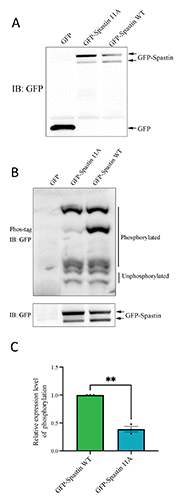Phosphorylation mutation impairs the promoting effect of spastin on neurite outgrowth without affecting its microtubule severing ability
- PMID: 36632786
- PMCID: PMC10300427
- DOI: 10.4081/ejh.2023.3594
Phosphorylation mutation impairs the promoting effect of spastin on neurite outgrowth without affecting its microtubule severing ability
Abstract
Spastin, a microtubule-severing enzyme, is known to be important for neurite outgrowth. However, the role of spastin post-translational modification, particularly its phosphorylation regulation in neuronal outgrowth, remains unclear. This study aimed to investigate the effects of eliminating spastin phosphorylation on the neurite outgrowth of rat hippocampal neurons. To accomplish this, we constructed a spastin mutant with eleven potential phosphorylation sites mutated to alanine. The phosphorylation levels of the wildtype spastin (WT) and the mutant (11A) were then detected using Phos-tag SDS-PAGE. The spastin constructs were transfected into COS7 cells for the observation of microtubule severing, and into rat hippocampal neurons for the detection of neuronal outgrowth. The results showed that compared to the spastin WT, the phosphorylation levels were significantly reduced in the spastin 11A mutant. The spastin mutant 11A impaired its ability to promote neurite length, branching, and complexity in hippocampal neurons, but did not affect its ability to sever microtubules in COS7 cells. In conclusion, the data suggest that mutations at multiple phosphorylation sites of spastin do not impair its microtubule cleavage ability in COS7 cells, but reduce its ability to promote neurite outgrowth in rat hippocampal neurons.
Figures




Similar articles
-
UCHL1-Mediated Spastin Degradation Regulates Microtubule Severing and Hippocampal Neurite Outgrowth.J Mol Neurosci. 2025 Apr 24;75(2):54. doi: 10.1007/s12031-025-02348-1. J Mol Neurosci. 2025. PMID: 40272610
-
Spastin Interacts with CRMP2 to Regulate Neurite Outgrowth by Controlling Microtubule Dynamics through Phosphorylation Modifications.CNS Neurol Disord Drug Targets. 2021 Oct 26;20(3):249-265. doi: 10.2174/1871527319666201026165855. CNS Neurol Disord Drug Targets. 2021. PMID: 33109053 Review.
-
Spastin Interacts with CRMP5 to Promote Neurite Outgrowth by Controlling the Microtubule Dynamics.Dev Neurobiol. 2018 Dec;78(12):1191-1205. doi: 10.1002/dneu.22640. Epub 2018 Oct 21. Dev Neurobiol. 2018. PMID: 30257070
-
Rab3A interacts with spastin to regulate neurite outgrowth in hippocampal neurons.Biochem Biophys Res Commun. 2023 Feb 5;643:77-87. doi: 10.1016/j.bbrc.2022.12.066. Epub 2022 Dec 23. Biochem Biophys Res Commun. 2023. PMID: 36587525
-
Hereditary spastic paraplegia SPG4: what is known and not known about the disease.Brain. 2015 Sep;138(Pt 9):2471-84. doi: 10.1093/brain/awv178. Epub 2015 Jun 20. Brain. 2015. PMID: 26094131 Free PMC article. Review.
Cited by
-
Novel compound heterozygous CNGA3 mutation associated with retinal cone dystrophy.Exp Ther Med. 2025 Jun 10;30(2):155. doi: 10.3892/etm.2025.12905. eCollection 2025 Aug. Exp Ther Med. 2025. PMID: 40529388 Free PMC article.
-
CaMKIIβ-mediated Phosphorylation Enhances Protein Stability of Spastin to Promote Neurite Outgrowth.J Neurosci. 2025 Aug 6;45(32):e1995242025. doi: 10.1523/JNEUROSCI.1995-24.2025. J Neurosci. 2025. PMID: 40645772
-
UCHL1-Mediated Spastin Degradation Regulates Microtubule Severing and Hippocampal Neurite Outgrowth.J Mol Neurosci. 2025 Apr 24;75(2):54. doi: 10.1007/s12031-025-02348-1. J Mol Neurosci. 2025. PMID: 40272610
References
-
- Zhu Z, Zhang C, Zhao G, Liu Q, Zhong P, Zhang M, et al. . Novel mutations in the SPAST gene cause hereditary spastic paraplegia. Parkinsonism Relat Disord 2019;69:125-33. - PubMed
MeSH terms
Substances
LinkOut - more resources
Full Text Sources

